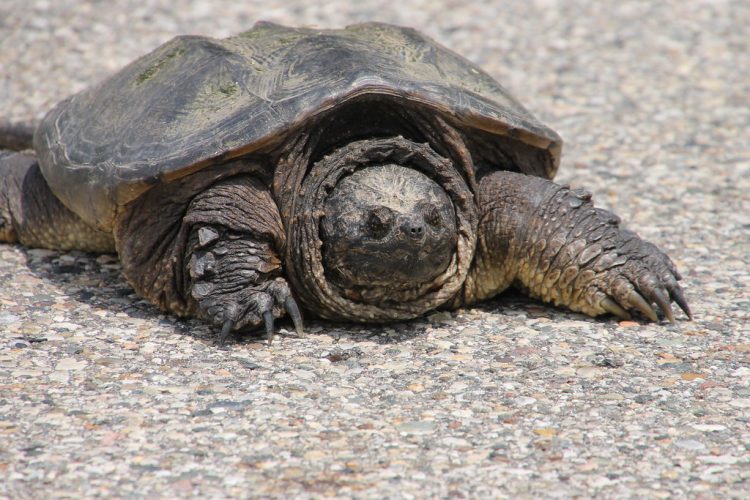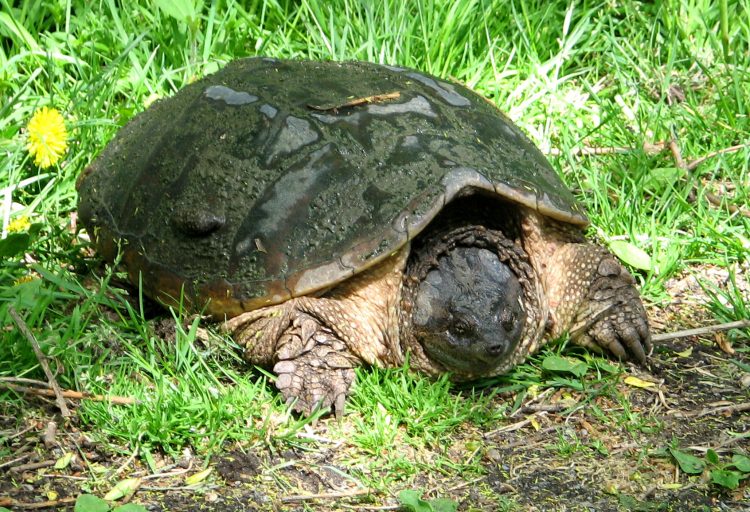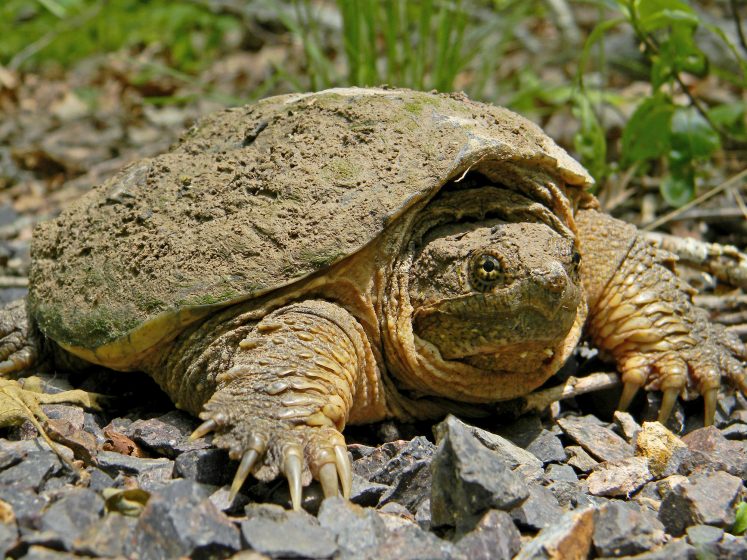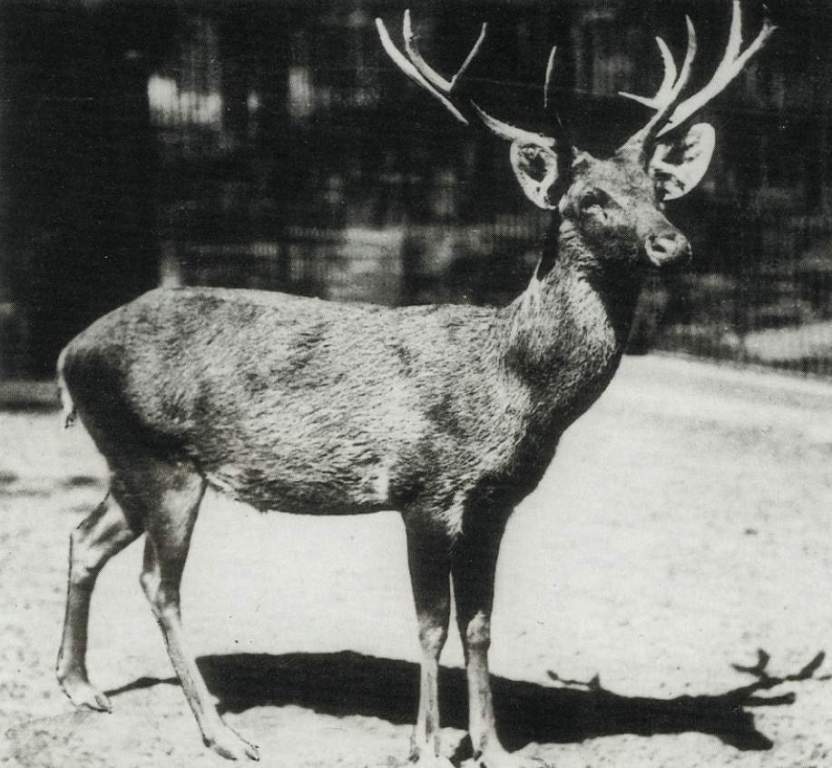Where do Snapping Turtles live?
Snapping turtles are among the largest freshwater turtles. They are characterized by large heads with powerful, hooked jaws. There are only two species of this family in North America. The snapping turtle, including both the common and Florida snapping turtles, and the alligator snapping turtle are mostly found in lakes, streams, and freshwater where fish are in abundance. The snapping turtle (Chelydra serpentina) is primarily aquatic, inhabiting freshwater and brackish environments, although it will travel overland. The two subspecies recognized in North America that are primarily distinguished by range.
s. serpentine (the common snapping turtle, which is the largest subspecies, primarily occupies the United States east of the Rockies, except for the southern portions of Texas and Florida), and C.s. osceola (the Florida snapping turtle, found in the Florida peninsula).
Snapping Turtle Size
An adult snapping turtle is large, 20 to 37 cm in carapace length. Although male turtles attain larger sizes than females,. In a large oligotrophic lake in Ontario, Canada, adult males averaged more than 10 kg. Hence, the female turtle averages 5.2 kg. In other populations, the difference in size between males and females is often less. Snapping turtles reach sexual maturity at about 200 mm in carapace length. The cool, brief activity season in more northern areas results in slower growth rates and extended times to reach sexual maturity.
Snapping Turtle Habitat
In the east, snapping turtles are found in near-permanent ponds, lakes, and marshes. However, in the arid west, the species is primarily found in larger rivers because these are the only permanent water bodies. They are often found in turbid waters with a slow current. They spend most of their time lying on the bottom of deep pools or buried in the mud in shallow water, with only their eyes and nostrils exposed. It is observed that young snapping turtles show a preference for areas with some obstructions that may provide cover or food. The turtle has the great ability to travel extremely long distances to find food or an appropriate area to lay its eggs.
What do snapping turtles eat?
Snapping turtles are omnivorous. In the early spring, when limited aquatic vegetation exists in lakes and ponds,. They may eat mainly animal matter. Though, when aquatic vegetation becomes plentiful, they become more herbivorous. Also, young snapping turtles are chiefly carnivorous and like smaller streams where aquatic vegetation is less abundant.
Snapping turtles consume a wide variety of animal material. That includes insects, snails, crustaceans, clams, leeches, earthworms, tubificid worms, freshwater sponges, fish (adults, fry, and eggs), frogs, toads, salamanders, small snakes, small turtles, birds, small mammals, and carrion and plant material, including several algae.
Snapping Turtle observed no difference between the diets of males and females who fed at the surface, mid pelagic, and benthic levels. The pharyngeal mechanism of feeding (i.e., drawing water with food objects into the mouth) prevents snapping turtles from ingesting food above the air-water interface.
Temperature Regulation and Daily Activities
Snappers are most active at night. They do occasionally come ashore during the day to bask, although this is likely limited by their sensitivity of extreme heat and their quick moisture loss. It was found that the turtles were active in the early morning and early evening and basked in the afternoon, but were rarely active at night. Active turtles were found in deeper waters than inactive snappers. Cloacal temperatures of 18.7 to 32.6 °C were reported for snapping turtles captured in the water in Sarasota County, Florida, between May and October.
Snapping Turtle Hibernation
Snapping turtles habitually enter the hibernation process at the end of October and emerge sometime between March and May. But it all depends on latitude and temperature. Also, to hibernate, turtles burrow into the debris or mud bottom of ponds or lakes, settle beneath logs, or retreat into muskrat burrows or lodges. The turtles have been seen moving on or below the ice in midwinter. Large congregations sometimes hibernate together. This turtle is incredibly cold-tolerant; it even remains active under the ice during the winter.
Snapping Turtle Breeding Activities
Mating occurs any time turtles are active, from spring through fall, depending on latitude. Some investigators believe that male snapping turtles are territorial but doubt that males defend their home ranges against other males. Sperm may remain viable in the female for several years. Nesting occurs from late spring to early fall, peaking in June. Snapping turtles can travel long distances overland to reach a new destination. They do it because of pollution, food scarcity, the destruction of habitat, overcrowding, and many other factors.
When do snapping turtles lay eggs?
The older females nested earlier in the season than did the smaller, younger ones. Females often move up small streams to lay eggs. The nest site may be in the soil of banks or in muskrat houses, but more commonly, it is in the open on south-facing slopes and maybe several hundred meters from the water.
The turtle digs a 4- to 7-inch cavity on dry land, preferably in sand, loam, or vegetable debris. The duration of incubation is inversely related to soil temperature. In more northerly populations, hatchlings may overwinter in the nest.
Home Range and Resources
Moreover, many turtles stay mainly within the same marsh or in one wide-ranging area from year to year. The summer home range includes a turtle’s aquatic foraging areas, but females may need to travel some distance outside of the foraging home range to find a suitable nest site.
The females tagged at their nesting site moved an average of 5.5 km from the nest site afterward. Though, 91.9 percent of the turtles in one population returned to the same nesting site a year after having been tagged there,. Home ranges overlap both between and within sexes.
However, the young snapping turtles use different habitats than adults; they tend to remain in small streams until shortly before maturity, when they migrate to habitats preferred by adults (e.g., ponds, marshes, and lakes).
Population Density
The density of snapping turtles appears to be positively correlated with the productivity of the surface water body (e.g., density in a eutrophic surface water body is higher than in an oligotrophic lake). Specific habitat characteristics and intraspecific interactions contribute to the variability of observed population densities in snapping turtles.
Snapping Turtle Egg Incubation
Females do not begin laying eggs until age 6 to 19 years, depending on latitude and when they reach an appropriate size (approximately 200 mm carapace). Males mature a few years earlier than females. However, females may lay 1 or 2 clutches per season.
Snapping turtle egg incubation took around 90 days. However, it all depends on the average temperature during that time, hatch anywhere from 80 to 120 days after being laid. Clutch size increases with female body size, calculated as the relationship between clutch size and plastron length.
Clutch size has also been positively correlated with latitude. The mammalian predators destroyed over 50 percent of the turtle nests. In the undisturbed nests, hatchling success was less than 20 percent. Adult mortality is low, corresponding with the long lives exhibited by these turtles.
Snapping Turtles Predators
The eggs are preyed on by crows, foxes, mink, skunks, and raccoons. The hatchlings and juveniles, most of the same predators as well as herons, as it is observed that they are mostly attacked by great blue herons, yellow bitterns, fishers, hawks, owls, bullfrogs, large fish, and different snakes. The average lifespan is not known, but the estimated life is more than a hundred years.
Similar Species
The alligator snapping turtle (Macroclemys temmincki) is much larger (16 to 68 kg; 38 to 66 cm carapace) than the common snapping turtle and is one of the largest turtles in the world. Its range is from northern Florida to east-central Texas and north of the Mississippi Valley.
Are snapping turtles poisonous?
Snapping Turtle’s biggest threat to humans is their powerful bite and scratch. So be careful when you interact with him to avoid the danger of their bite and claws, which are very sharp and lacerate the flesh of a person trying to calm them. The snapping turtle can also cause some serious bruises, break the skin, or break bones as well.











